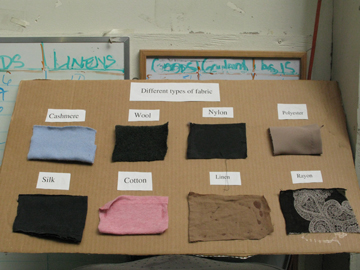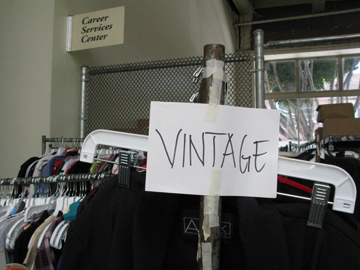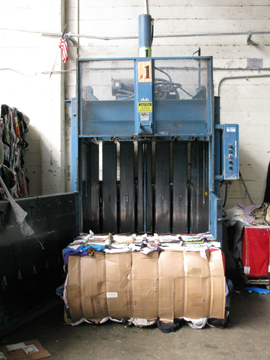Nearly a year and a half ago, my research about clothing recycling options led to an invitation for a personal tour of the San Francisco-based processing facility of Goodwill Industries of San Francisco, San Mateo, and Marin counties.
Each regional Goodwill chapter is at liberty to establish its own programs and initiatives, and locally, these focus on the following triple bottom line: job training and skills development, revenue generation, and recycling.
Goodwill Industries San Francisco’s commitment to a sustainable environment has led to the creation of an environmental business which includes creative reuse, retail sales, and bulk materials sales that combined, keep tons of material out of the landfill. Among this is an annual 260 tons of salvage textiles.
Here’s a photo essay (of course my camera was in tow!) that reveals what can happen to clothing and textiles:
Donated items arrive at Goodwill’s central processing facility in San Francisco for sorting, inspection, and distribution. The work is done by participants in Goodwill’s diverse job training programs. Part of the mission is to create “solutions to poverty through workforce creation” and to “build sustainable livelihoods.” As I witnessed during the tour, this training occurs at all phases throughout the facility.
Boxes of unsorted clothing stacked on pallets await processing.
The first step in the actual triage process: workers sort through each and every piece of donated clothing. Sellable items are separated from the stained, damaged, and torn clothing. The former will work their way through the local retail chain, and the latter will be directed to the baler (several images below).
A board with fabric swatches is on hand to educate workers how to distinguish the different types of fabric by feel.
Clothing destined for Goodwill retail outlets is sorted by type and then by Bay Area retail outlet venue. Clothing is designated as vintage, designer, jeans, sweater, jerseys, costumes…you name it. Inventory management is one of the transferable skills workers learn during this part of the process.
Detail of a rack of vintage clothing.
When unsold clothing is returned from the retail outlets, it is made available for rock bottom prices in the Goodwill As-Is Store, located at the main processing facility. I was told this is a goldmine for keen treasure-seekers. This is the final retail stop before unwanted clothing heads to the baler.
The baler with a fresh bale of clothing. Operation of the baler requires special training, and it is one of the skills workers can bring to other industries where balers are used. (The forklifts and trucks also require specialized training of these vital transferable skills.)
As part of Goodwill’s solid waste reduction, these bales of unsellable textiles are sold in bulk to companies that in turn sell to the rag trade. These vendors might remove buttons and other reusable parts prior to ragmaking and further recycling.
These bales were awe-inspiring. The textiles are so tightly compressed and bundled into a solid colorful mass.
The tagline that dons their fleet of trucks (run on a 20% biodiesel blend!) and their current advertising campaign is “Goodwill not landfill.” It’s great to know, too, that this Goodwill Industries chapter is working on becoming part of the Bay Area Green Business Program.
Please keep in mind, this is just a tour of what happens to the clothing at this facility! There are also mounds of shoes, handbags, jewelry, electronics, household items, plastics, books, and more that are processed and sold and redistributed.
Some personal post-tour thoughts…
The creativity, innovation, systems, and overall atmosphere that exist in this facility filled me with an overwhelming sense of gratitude and a tinge of despair. While I’m so thankful that this important mechanism for job creation and recycling exists in the heart of our community, I couldn’t help but be taken aback by the sheer mass of disposed objects we, collectively, consume as a culture and easily pass along. In this instance, though, our consumptive nature has led to the establishment of vital social, economic, and environmental solutions.
Now imagine if we were more mindful of our retail diets…

















Nice essay. I esp. agree with the part about reducing waste.
Pingback: Tackle That Clutter! « A Good Look by GoodwillNyNj
Pingback: Oprah Says Tackle That Clutter! « A Good Look by GoodwillNyNj
This is a great photo essay. I had no idea what all went on once you donate your clothes. I feel even better about donating my stuff to them.
Thanks, Samantha. I also recommend that you inquire what happens to clothing donations at your regional Goodwill. It was surprised to learn that not all Goodwill’s have the same processes and policies. Here in San Francisco they are providing an active and vital role in helping the city and county’s efforts to achieve 75% of solid waste diversion from landfill this year!
This is such an interesting photo essay…I always wonder how Goodwill manages ALL the donations they get. It seems like such a mess, but it’s good to know they have a well thought out operation. We should all be more concious about what we buy!
Thanks for the pictures! I’ve been dropping off clothes at Goodwill for years and had no idea how all the behind-the-scenes stuff worked.
I also have recently become a fan of GW Boutique, as my friends and I call it…why pay $70 for jeans when you can find a decent pair at Goodwill for $6?? Reduce, reduce, reduce!
Thanks again, great essay!
Pingback: Liberate Your Space! « A World of Words
I feel a quilt coming on….
I’ve been an employee of Goodwill Industries of North Central Wisconsin for 5 years. I encourage everyone to ask at their local Goodwill…”What happens to my donations?”
Its different at every store, and every region, but we all strive for the same thing…helping people while creating the money to do so and lessening our impact on the planet. Keep shopping at Goodwill! 🙂
Yes, keep shopping at Goodwill AND keep recycling there, too. Our “treasures” are constantly finding and needing new homes when we are through with them!
Thanks! I always wanted to know what happened behind the scenes.
And for an artistic yet functional (not to mention costly) twist on how those bales of textiles destined for the rag trade can be reused, check out The Droog Chair: http://www.droog.com/products/0/rag-chair/
I can’t help but wonder how much one of these chairs weighs!
Pingback: Earth Day is Coming! 3 Ways to Organize “Green” | Fat Hog
Pingback: Hautelinks: Week of 4/22/10 – College Fashion
Sadly, the Goodwill in our county discards alot of the donations when they have “too many” to deal with. Just adds to the mountain of a landfill in the north valley!
🙁
Good article. I “rent” stuff from Goodwill. I buy it and if I don’t use it I re-donate it. At least it doesn’t go in the waste stream.
Pingback: A basement full of books « liberated spaces
Hi,
I am an artist who needs some typical household items for use in building sets. I called the Goodwill to see if they had unsellable items that I could use, but they said no. Does anyone know a place where I could intercept such items?
Thanks.
What type of household items? Where r u located?
Forrest.
Oh, that’s disappointing. You may wish to check with freecycle.org to see if there’s a local group where you live. This is a fabulous venue for posting a request for specific items you seek, and chances are one of your “neighbors” may be able to provide. I’ve seen some amazing requests get filled.
Crazy as this sounds, you may want to shout out to your friends and let them know what you’re looking for. This may motivate some folks to purge and know their castoff kitchen items are going to a good person and cause!
Good luck and please let us know what you do.
And here’s what’s happening in NYC – a city-wide initiative for textile and shoe recycling: http://www.ecouterre.com/new-york-city-to-recycle-clothing-shoes-textiles-starting-this-fall
Pingback: Charity, Profit or Waste? The Real Scoop on Clothing Donations - 1-800-Recycling
Pingback: Goodwill Outlet Store AKA "The Bins" | Chic Steals
Pingback: Goodwill – not – Landfill – Guest Blog Post – Debra Baida
This is a good article. Part of the reason people don’t donate scrap textiles to Goodwill, Saint Vincent’s, etc, is that when you call their stores to ask, the store clerks don’t know what happens to the nonsalable items like scrap rags or torn clothing, because they mainly want stuff they can sell, and they discourage you from dropping them off at their stores.
Good Will, St. Vincent de Paul, and Salvation Army could do a better job of telling their employees that these items can be accepted.
Thank you for reading and for commenting, Linda. I agree that educating employees about how best to communicate what their respective organization does/not accept and why is vital. Equally vital is for these organizations to be able to refer donors to other local nonprofits that can accept what they do not. I’ve been encouraging Goodwill of San Francisco, San Mateo, and Marin to have information for other nonprofits at their donation drop off venues. It’s a service to their donors, and I’m happy to report this is something they are working on.
Pingback: Goodwill - not - Landfill - Guest Blog Post - Debra Baida | DownshiftingPRO
During WWII, I remember the “Rag Man” in his truck. For months, I have been seeking a service which will take unusable clothing. Is there anyplace near 45056?
I wish there was a directory or guide with this information, but such resources are ever-changing. And finding a venue for unusable textiles can be difficult. My best recommendation – which you may have exhausted already – is to contact all donation venues and the municipal waste management company near you to inquire about options and/or recommendations.
Thank you re municipal waste manager..
You’re welcome. I hope they can provide leads.
Last night, too, I had a thought that if these textiles were clean, perhaps you might find a local artisan who works with scraps and could use them in their work. Best of luck. I know this can be difficult and frustrating.